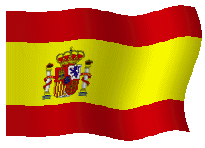
THE HOME WINE COURSE ©

Introduction:
The wine culture of Spain traces its origins to the Roman Empire, as is the case with nearly every other wine-oriented country in Europe. Following the Roman Empire's collapse, viticulture was kept alive by the Arabic Moors, who were subsequently replaced by Spanish Catholics. Spain's warm climate assured a substantial grape harvest yearly, allowing Spanish wines to compete favorably during the Middle Ages with those of Italy and France. However, quality controls did not keep pace with either of these two countries, and, although vineyard acreage is the highest in Europe, production levels are not as prolific. Premium wines in Spain are of recent origin, are primarily reds, and are mostly found in the northern third of the Spanish peninsula. With the exception of Jerez in the far coastal south, we will be tasting wines from the more temperate northern wine districts of Spain.
(1) Rioja
Rioja is located in north central Spain about two hundred miles northeast of Madrid along the western segment of the Ebro River. The Rioja region is divided into three primary subdistricts: Rioja Alta, Rioja Alavesa, and Rioja Baja. The Rioja Alta district is acknowledged as superior to the rest, producing elegant reds primarily composed of the Tempranillo grape, with small proportions of Garnacha (Grenache), Mazuela, and Graciano. Extended aging in American and French 60 gallon barriques gives Rioja wines their distinctive soft, vanillin-scented character. These wines are considered to be Spain's finest and indeed the best Riojas have world-class status with understandably higher prices but, even so, Rioja remains one of the best fine wine bargains of Europe. White Riojas are produced in limited quantities using the Viura grape, sometimes blended with either Malvasia or Garnacha Blanca. Modern white Rioja is made in a fresh, dry style, while the Reservas can have a slight oaky nuttiness. Red Riojas are classified at three levels of quality: Crianza (vintage wines aged at least one year in 'barricas'), Reserva (richer wines, usually aged up to two years in oak), and Gran Reservas (the finest reds, aged two to five years in oak).
Tasting Notes:
(2) Ribera del Duero
The Ribera del Duero is located in the heart of the plain of Old Castile on the Duero River in north central Spain. The growing season here is quite hot and usually very dry. The Ribera del Duero district is a tenth of the size of Rioja but its high quality red wines are quickly establishing a comparable, world-class reputation. As in Rioja, Tempranillo and Garnacha grapes are used with an increasing acreage of Cabernet Sauvignon, Merlot, and Malbec being planted. The wines can be similar in character to fine red Bordeaux, however some examples which are aged in American white oak (including Pesquera and Viña Mayor) can be quite close to reserve-level California Cabernet wines. Spain's most expensive red wine comes from the Ribera del Duero's Vega Sicilia estate whose Unico label can sell for as much as any Premier Grand Cru Bordeaux. Quality designators here can be confusing but look for three basic terms: Cosecha (meaning vintage wine), Crianza (vintage wine, aged in oak one year), and Reserva (first-quality vintage wine aged two or more years in barrica).
Tasting Notes:
(3) Penedès
The Penedès district is located in the northeastern coastal area of Spain, just south and west of Barcelona. Production here is roughly half that of Rioja, with reds wines predominating except in San Sadurní di Anoia where Spanish cava (sparkling wines) are made. The reds of Penedès are typically heavier and fruitier than those of Rioja perhaps because more Cabernet Sauvignon is blended with the traditional Ull de Llebre (a synonym for Tempranillo). Other varietals used in Penedès red blends include: Garnacha, Monastrell, and Cariñena (Carignan). Crisp, clean white wines and sparkling wines are made with the Parellada, Xarel-lo, and Macabeo varietals, with some fruity Malvasia used as well. French and Germanic white varietals are also being experimented with here, primarily by the Torres estate, where rather pricey Spanish Chardonnay, Sauvignon Blanc, Riesling, and Gewurztraminer are made. Quality designations here are similar to those found in Rioja with Crianza, Reserva, and Gran Reserva designations.
Tasting Notes:
(4) Somontano/ Navarra
The Somontano and Navarra regions are located in the north central area of Spain, east of Rioja, in the foothills of the Pyrenees Mountains. Although rather small viticultural districts, Somontano and Navarra have a growing appeal for American wine enthusiasts because of the bright, fruit-filled wine styles produced here. Carbonic maceration is commonly used in making Somontano reds, allowing the vibrancy of Beaujolais-like berry flavors found in these charming wines. On the other hand, Navarra wines, made with traditional fermentation techniques, can be quite powerful. Tempranillo, Moristel, Allañon, Garnacha, Pinot Noir, Merlot, and Cabernet Sauvignon grapes are grown in Somontano and Navarra and are blended in various proportions to give these wines their spritely character. Crianza is the quality classification most often seen in these regions because extended oak-aging is not required for the lighter Somontano style of winemaking. Intensely-flavored, oak-influenced Reservas that compete well with big California reds are increasingly popular in Navarra. Montesierra and St. Marc are two popular wine estates in Somontano whose wine can be found in the United States. Guelbenzu is a top Navarra estate being sold here as well.
Tasting Notes:
(5) Jerez (dry) (6) Jerez (sweet)
Jerez is located in the southern central coastal area of Spain, northwest of Gibralter and south of Seville. The fortified (brandy-added) Palomino, Moscatel, and Pedro Ximenez white wines of Jerez known to the world as Sherry are undoubtedly the most famous wines of Spain. Who hasn't heard of Harvey's Bristol Cream? But Sherry has much more variety than this single well-known wine. Actually, the sweeter Oloroso and Cream types of Sherry are a favorite choice of Brits and Americans, but the Spanish prefer their bone-dry Manzanilla, Fino, and Amontillado types of Sherry. The primary difference in these wines is their relative time spent maturing in oak barrel soleras (pyramid stacks) where the treasured flor mold develops on the wine's surface adding the character that makes Sherry wines so unique. Manzanilla and Fino are the most dry and delicate, with light straw to bright golden hues, and are at about 17-18% alcohol. Amontillados and Olorosos spend more time in wood under the flor, and are typically darker and sweeter (due to an addition of concentrated sweet Pedro Ximenez wine) and have about 20-21% alcohol. Reserve-level Sherries called Almacenistas can be found, and are justifiably more expensive. Seek out the Sherry wines of Emilio Lustau for great value and exceptional quality.
Tasting Notes:
